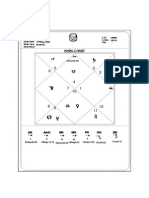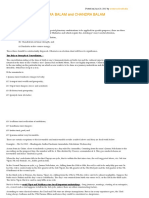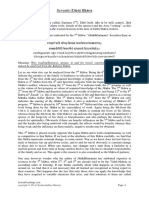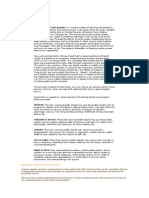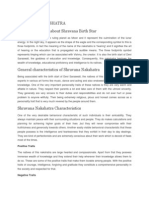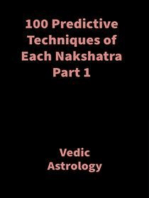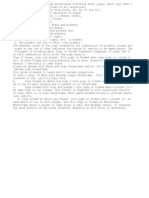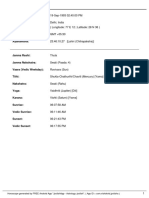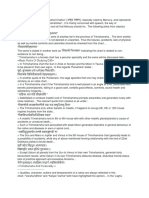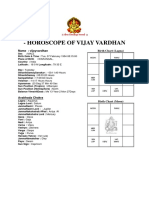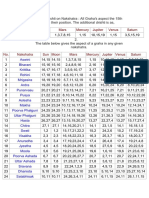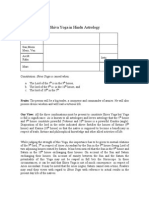Gulika in Vedic Astrology
Gulika in Vedic Astrology
Uploaded by
CatchdgreenCopyright:
Available Formats
Gulika in Vedic Astrology
Gulika in Vedic Astrology
Uploaded by
CatchdgreenOriginal Description:
Original Title
Copyright
Available Formats
Share this document
Did you find this document useful?
Is this content inappropriate?
Copyright:
Available Formats
Gulika in Vedic Astrology
Gulika in Vedic Astrology
Uploaded by
CatchdgreenCopyright:
Available Formats
Gulika holds a position of prime importance in the evaluation of a natal chart.
Also called as Maandi, it, like Rahu and Ketu, has no physical existence. But it always makes a difference in the natal chart output. Gulika is generally considered the most malefic entity in a chart. According to the set standards of assessment of maleficence, it surpasses all natural malefics. Gulika enjoys a special status almost like an independent planet, and in astrological classics it is considered as a minor planet or subplanet. In the traditional astrological practice, the Gulika-Kundali (a horoscopic chart, with houses reckoned from the position of Gulika) used to be an essential component of the Janma-patri (the scroll carrying the horoscopic details of a native, according to the traditional system of making horoscopes in India).
Gulika and Maandi
In Vedic astrology, Gulika and Maandi are considered synonymous although some people try to differentiate between them. Gulika denotes a certain segment of time controlled by Saturn. The word Maandi is derived from Manda or sluggish, another name of Saturn. According to the Brihat Parashara Hora Shastra : ukekUrja rq rL;So ekfUnfjR;fHk/kh;rsAA That is: Of the same (i.e., Gulika), another name is Maandi.
Fixing the Gulika
The position of Gulika is different for daytime (from sunrise to sunset) and night time (from sunset to sunrise). The duration of the day or of the night (as the case may be) is divided into eight parts. The segment belonging to Saturn is known as Gulika. For daytime, the first segment (the first one-eighth of the night) belongs to the planetary lord of the weekday that falls fifth from the weekday under consideration. The subsequent segments belong similarly to other planets that rule the weekdays in natural order. The eighth part here too is without a lord. In each case the part belonging to Saturn is called as Gulika.
The Controversy
The segment of Saturn during the day or during the night would have some duration. Some people think that the ending moment of Saturns segment is the time to calculate the position of Gulika. They determine the ascendant for the ending moment of Saturns part; the cusp thus obtained is considered the longitude of Gulika. However, the above-mentioned concept results from an erroneous nderstanding of the shloka from the Brihat Parashara Hora Shastra, which is as follows : xqfydkjEHkdkys ;r~ LQqVa ;TtUedkfyde~A xqfyda ksP;rs rLekr~ tkrdL; Qya onsr~AA That is: The cusp of the sign rising at the beginning of the Gulika segment is considered as Gulika-from this the chart must be analysed. There is a popular, but vague, method of finding out the Gulika. According to this, for a day of 30 Ghatis, the rising time for Gulika during the day, for the seven days from Sunday to Saturday, is at 26, 22, 18, 14, 10, 6 and 2 Ghatis from the time of sunrise. For night time, the order from Sunday onwards is 10, 6, 2, 22, 18 and 14 ghatis from sunset. This method is not accurate. The Prashna Marga, a south India treatise, also refers to the Gulika and Maandi being the same.
Results of Gulika
Gulika in the first house most certainly reduces the good results of the chart. The impact is maximum in malevolence when the cusp of the lagna and the Gulika are close in degrees. This means that birth taking place at the commencement of the Gulika-kaala suffers the maximum affliction. In such a situation, the Raja-yogas or other benefic yogas lose their potence. The Phala-deepika states: xqfydL; rq la;ksxks nks"kkUloZ=k fufnZ'ksr~A That is: Determine all adverse results from Gulikas association. When the nakshatra of the lagna and Gulika are mutually trinal, the basic benevolence of the lagna nakshatra lord (LNL) is lost. Nakshatras 1, 10 and 19 are mutually trinal. Gulika spoils the benefic significations of most of the houses by occupying them. Thus, all troubles ensue when Gulika occupies the lagna. In the second house, it curtails family comforts and financial savings. Poor social status results when Gulika occupies the fourth house. In the fifth, it leads to troubles from progeny. And so on.
Of all the sub-planets, Gulika and Yamakantaka (the subplanet represented by Jupiters segment) surpass all others in maleficence and beneficance respectively. Only in houses 3, 6, 10 and 11 does Gulika generate benefical results. In the tenth house, however, it indicates delay in getting established in a career. The good results of Gulika (from its placement in the above houses) are lost when the rashi and navamsha lords of Gulika are neecha (debilitated) or combust.
Gulika with Natural Karakas
The association of Gulika with a natural Karaka (significator) always destroys the good effects of that Karaka. Classics hold the opinion that Gulika conjunct with the Sun creates lack of comforts for father, with the Moon it is bad for mother, and with Mars it is adverse for brother. When Gulika joins Mercury, the native becomes mentally disturbed. With Jupiter, the native becomes a hypocrite. Gulika with Venus brings troubles from women and ruins marital life. Association with Saturn leads to disease and skin disorder, with Rahu it leads to proneness to infection, and with Ketu fear from fire. Gulika can alter the results of other planetary yogas in the chart. All good yogas are lost when the birth time and the Gulika-Kaala coincide together with another inauspicious factor like Mahapaata, Gandanta, Visha-Ghati, etc. (refer to our article: Pitfalls in Astrology, vide the Vedic Astrology Vol. 5, No. 3, May-June 2001 issue). In Chart 1 (born on May 6, 1982; at 11:30 hours; in Nepal), the lagna is Karka (Cancer), at 2306'. Gulika lagna is 2S1154', associated with Rahu. The native is mentally retarded. A Mahapaata birth is also confirmed here.
A Special Rule
A point 180 from Gulika is also considered as acutely malefic in the natal chart. This point must be taken into consideration when the lethal potential of a planet is to be determined. This is better known as the Pramaana Gulika in Vedic astrology. The dispositor of Gulika or Pramaana Gulika may prove fatal during its dasha, etc., displacing the other maraka or killer planets.
Dashas and Transits The dasha periods of the dispositor of Gulika or its navamsha lord may prove hazardous. Chart 2 (born on October 17, 1955; at 17:30 hours; at Pune) belongs to an erstwhile famous ?? actress, Smita Patil. Her lagna is Meena (Pisces) while Gulika occupies Makara (Capricorn) in the eleventh house. She died of meningitis in the Saturn-Mars period. Saturn is the rashi lord of Gulika while Mars is its navamsha lord. Gulika in houses 1, 5 or 9 authorises the lagna lord to disburse the maraka effect during its dasha. Trouble results during the dasha of a planet that happens to be an associate of Gulika in the rashi chart. Severe troubles are also likely during the dasha of any planet associating with Gulika in the navamsha or the dwadashamsha charts. Specially adverse results ensue during the dasha period, of Jupiter or Saturn when they associate with Gulika in the navamsha, or the dasha of the Sun when it associates with Gulika in the dwadashamsha, or that of the Moon associating with Gulika in the Trimamsha chart. The Pramaana Gulika deserves the same treatment as Gulika (vide supra). The transit of Saturn and Jupiter over the navamsha sign lord of Gulika, that of the Sun over the Dwadashamsha sign lord of Gulika, and that of the Moon over the Trimshamsha sign lord of Gulika, put the native in trouble. This is according to the Prashna Marga, which states: eUnkseq"; uoka'kikfJrx`gs e`R;qnk;h xq#& HkkZuq}kZn'kHkkxikfJrx`gs f=a'kka'ki{ksZ 'k'khA All trikona (1, 5, 9) rashis should be considered in application of transits.
Gulika and Accidents
Gulika is extremely important as an active killer in Vedic astrology. It is used in the judgement of longevity, along with dasha and transit.
The lagna, the Moon and Gulika falling in Dwiswabha (dual) or Sthira (fixed) signs prompt multiple ailments and fatality. In Chara (movable) signs, it leads to good health and long life. The lagna, the Moon and Gulika falling in mutual trikonas in the navamsha chart, particularly in rashis 4, 8 and 12 are fatal. Such a native is disease prone and accident prone. This is according to the following dictum of the Prashna Marga: sphnt vU;ksU;a ;fn rs f=dks.kHkxrk Hkkxk egkjksxnkA n`"Vk eksgdjk ;qrk ej.knk% dfdZf=dks.ks n`<+e~AA
Gulika and Longevity
For the calculation of longevity, the lagna, the Moon the Sun and Gulika are all important. A special rule for assessment of longevity involves using the cusp of the lagna and the longitudes of the Sun, the Moon and Gulika. This is as follows: Lagna 5 + Gulika = Prana Sphnt Moon 8 + Gulika = Deha Sphnt Gulika 7 + Sun = Mrityu Sphnt When the sum of Prana and Deha is more then the Mrityu, the native is likely to live long. However, if Mirtyu is bigger than the Sun of Prana and Deha, a rudder end of life is indicated. Chart 3 (born on November 19, 1917; at 23:11 hours IST; at Allahabad) belongs to the Late Indian Prime Minister Indira Gandhi. Here, the lagna is 3S2722', the Sun is 7S047', the Moon 9S0535' and Gulika 1S2923'. The sum of Prana and Deha is 1S216' while Mrityu is 2S1504'. The native met a tragic end. Although Gulika is favoured in the third house, it turns death-inflicting when joined by or aspected by Saturn. Gulika in the third with the Moon or receiving the full aspect of the Moon causes tuberculosis or other internal fatal disease.
Daily Results of Gulika
Add the cusp of the lagna to the longitude of Gulika. The month when the Sun transits the resultant sign leads to troubles and miseries.
The most hazardous day is when the Moon transits the sign obtained from adding the longitude of the Moon to that of Gulika. Add the lagna, the Moon and Gulika. The resultant rashi is to be considered fatal. The month, the day and the lagna indicated by the sum obtained above must be avoided in all major ventures. In the example (chart 3) given above, Gulika is at 1S2923'. This indicates Kanya (Virgo) navamsha, Mesha (Aries) Dwadashamsha and Vrishchika (Scorpio) Trimshamsha for Gulika. The native was shot dead on October 31, 1984 at around 10:00 hours IST, at Delhi (Chart 4). The ascendant is Vrishchika, with Saturn in Tula along with the Sun, Jupiter and Gulika are in Dhanu (Sagittarius). The Moon is in Makara (Capricorn) while the navamsha lagna is Meena (Pisces). Adding the Moon and Gulika of the native of chart 3, we get Meena (Pisces). This is in time with the rising lagna of chart 4 as well as with its navamsha lagna. The natal Gulika was in Mesha (Aries) Dwadashamsha (Chart 3). At the time of the fatal mishap, Jupiter and Gulika were in times of Mesha (see chart 4).
Gulika and Progeny
Gulika in the fifth house, particularly in rashis 3, 6, 10 and 11, leads to lack of children. In such a situation, the native is likely to have some defect in his generative organs. Gulika may ensure successful conception when: (i) Gulika and the Moon are in the same sign; (ii) Gulika is with the fifth lord; (iii) Gulika is aspected by the fifth lord; (iv) Gulika in the other sign of the fifth lord; (v) Navamsha lords of Gulika and the Moon are related mutually. A successful conception results when Jupiter transits the times of Gulika rashi or Gulika navamsha rashi. When Gulika is in any of the first six rashis (Mesha to Kanya), consider the transit of Jupiter from the Gulika rashi. When it is in the last six signs (Tula to Meena), consider the transit from Gulika navamsha rashi.
Gulika in Special Lagnas
Gulika in houses 1 or 7 in the Pada Lagna causes grey hair, ill health and serious disease of the stomach.
When AK and Gulika occupy the Karkamsha lagna and both are aspected by the waxing Moon, there ensue losses from repeated theft. The native dies of poisoning if Gulika in Karkamsha lagna is not aspected by any planet. It may be noted that the same aspects, as applicable to the natal chart, are to be applied to all the special lagna charts like Karakamsha, Pada, Upa-pada, Navamsha, etc.
Raja-yoga from Gulika
The dispositor of Gulika, a its navamsha lord, placed in a kendra or trikona, or in its own sign or in exaltation, mollifies the adverse effects of Gulika and gives yoga effects, though its lethal propensity (markatwa) would remain intact. The Phaladeepika states: xqfydHkouukFks dsUxs ok f=dks.ks cfyfu futx`gLFks LoksPpfe=fLFkrs okA jFkxtrqjxk.kka uk;dks ekjrqy;ks efgri`Fkq;'kk% L;kUesfnuhe.MysU%AA That is: Let the Gulika be in a kendra, a trikona, or be strong, in its own house, or in exaltation or in a friendly house. A potent Rajayoga results from this disposition. In chart 3 (vide supra), Gulika is in the eleventh house. Its sign lord Venus is strong, in its own navamsha. The Gulika navamsha rashi lord in time shows a good and strong Raja-yoga. In the horoscope of Mr. Chandra Babu Naidu (Chart 5, born on April 27, 1951; at 6:30 hours IST; at Hyderabad), the lagna is 0S2216'. Gulika is 1S0837'. Gulika rashi lord Venus and navamsha lord Jupiter, are in there own signs. Its Dwadashamsha lord Sun is exalted. A strong Raja-yoga is formed and the native becomes powerful during Jupiter dasha. During Jupiter-Venus, the Raja-yoga results would be enhanced. Ms Jai Lalitha (Chart 6) was born on February 24, 1948; 14:34 hours IST; at Chennai. Gulika is at 1S2014' in the twelfth house. However, its rashi lord Venus is exalted in the tenth house. This exhibits a potential Raja-yoga.
To Mitigate the Evil
The evil of Gulika must be neutralised by prescribed remedies. Says Parashara: nhia f'koky;s HkDR;k xks?k`rsu nki;sr~A Parashara thus recommends that one should worship lord Shiva regularly in the evening, bow down to the Sun-god and lord Vishnu in the morning, and light a holy lamp of ghee before a Shiva temple. This would defy the evil arising out of an adverse disposition of Gulika.
You might also like
- Vedic ArudhaDocument25 pagesVedic ArudhanavkarNo ratings yet
- Karma of Marriage in Vedic AstrologyDocument20 pagesKarma of Marriage in Vedic AstrologySanjay Soni100% (1)
- Unknown Simple Remedial Measuresfor Each Nakshatrafrom Sahdev Bhadali ColorDocument5 pagesUnknown Simple Remedial Measuresfor Each Nakshatrafrom Sahdev Bhadali Colorknighthood4allNo ratings yet
- M.A. Jyothisyam Telugu UniversityDocument8 pagesM.A. Jyothisyam Telugu Universitygyansmruti83% (6)
- Gulika ACompilationDocument21 pagesGulika ACompilationkethavarapuramji100% (3)
- Nakshatra Facebook Research Technique3Document9 pagesNakshatra Facebook Research Technique3Srivathsala Suresh TangiralaNo ratings yet
- Basic Rules To Analyze Dashamansa KunDocument1 pageBasic Rules To Analyze Dashamansa KunHarry Hart100% (1)
- Navamsha Lord in The Timing DeathDocument9 pagesNavamsha Lord in The Timing DeathGeorgegeorgebNo ratings yet
- Indu Lagna and Janma LagnaDocument20 pagesIndu Lagna and Janma Lagnasachin100% (8)
- Yogini DashaDocument13 pagesYogini DashaSunil Rupani100% (2)
- Punarvasu Black & WhiteDocument50 pagesPunarvasu Black & WhiteRohit JainNo ratings yet
- DRISTIDocument4 pagesDRISTIsurinder sangarNo ratings yet
- JAIMINI ASTROLOGY - Calculation of Arudha - CS PATEL :A CASE STUDYDocument4 pagesJAIMINI ASTROLOGY - Calculation of Arudha - CS PATEL :A CASE STUDYANTHONY WRITER0% (1)
- Bhava ChandrikaDocument33 pagesBhava Chandrikavishveshraval565100% (1)
- Jataka YogavaliDocument20 pagesJataka YogavalibabanpNo ratings yet
- Ashwini YearsDocument5 pagesAshwini YearsSunil RupaniNo ratings yet
- Dashaphala Nirupana: Interpreting Graha DasaDocument4 pagesDashaphala Nirupana: Interpreting Graha DasaVaraha Mihira100% (2)
- Trish Ansh Chart and Inauspicious Times B WDocument14 pagesTrish Ansh Chart and Inauspicious Times B WNagarajanNo ratings yet
- ARUDHA WORKSHOP - Upapada (Lakshmi Ramesh)Document19 pagesARUDHA WORKSHOP - Upapada (Lakshmi Ramesh)S1536097F92% (12)
- PANCHAKA RAHITAM - TARA BALAM and CHANDRA BALAM - SreenivasdesabhatlaDocument5 pagesPANCHAKA RAHITAM - TARA BALAM and CHANDRA BALAM - SreenivasdesabhatlaArudra RaoNo ratings yet
- Secrets of Shastiamsa - 1 - Official Blog of Saptarishis Astrology - A Free Digital Astrology MagazineDocument12 pagesSecrets of Shastiamsa - 1 - Official Blog of Saptarishis Astrology - A Free Digital Astrology MagazineRavipr Paul100% (1)
- How To Predict Using Jaimini Chara Dasha: Yuvraj December 30, 2014 0Document36 pagesHow To Predict Using Jaimini Chara Dasha: Yuvraj December 30, 2014 0BadriaAliNo ratings yet
- Decoding DevakeralamDocument44 pagesDecoding Devakeralamnieo100% (2)
- Seventh BhavaDocument3 pagesSeventh BhavaAshish DeshpandeNo ratings yet
- Decoding of NadiamshaDocument8 pagesDecoding of NadiamshaAnonymous jGdHMEODVm100% (1)
- Bhava Chalit Chart - Notes 2Document2 pagesBhava Chalit Chart - Notes 2Khoo Hock Leong Khoo100% (2)
- Gulika - A Compilation: by A.G.Suresh Babu Shenoy, IndiaDocument21 pagesGulika - A Compilation: by A.G.Suresh Babu Shenoy, IndiaAnonymous jGdHMEODVmNo ratings yet
- Links To Rashis, Graha, Mahadashas - Vedic Astrology by Barbara Pijan LamaDocument1 pageLinks To Rashis, Graha, Mahadashas - Vedic Astrology by Barbara Pijan LamaANTHONY WRITERNo ratings yet
- 064 - Av of SunDocument16 pages064 - Av of SunTarun Garg100% (2)
- Arudha LagnaDocument22 pagesArudha LagnaHoracio TackanooNo ratings yet
- Gochara Phala - File-01Document18 pagesGochara Phala - File-01Anonymous TWzli5No ratings yet
- Indu Lagna & Income of A PersonDocument2 pagesIndu Lagna & Income of A PersonKrishna CHNo ratings yet
- Planetary Deaths (Maran Karak Sthan)Document2 pagesPlanetary Deaths (Maran Karak Sthan)nmremalaNo ratings yet
- Vedic Astrology - Maandi & GulikaDocument4 pagesVedic Astrology - Maandi & Gulikavkr91@yahoo.comNo ratings yet
- NadiAstrology1DrBVRamanPart2BW Edited PDFDocument9 pagesNadiAstrology1DrBVRamanPart2BW Edited PDFgift108100% (2)
- BhriguDocument3 pagesBhriguHoracio Tackanoo100% (1)
- Effects of Mandi (Gulikan) in Different Houses - Mercury JyotishDocument5 pagesEffects of Mandi (Gulikan) in Different Houses - Mercury JyotishDhananjaya K100% (2)
- Rath'S Lectures: Longevity Related Notes On Vimsottari DasaDocument5 pagesRath'S Lectures: Longevity Related Notes On Vimsottari DasasudhinnnNo ratings yet
- P.V.R. Narasimha Rao, USA: Example: Suppose Moon Is in KrittikaDocument33 pagesP.V.R. Narasimha Rao, USA: Example: Suppose Moon Is in Krittikarajarampai100% (1)
- Shravana NakshatraDocument2 pagesShravana NakshatramalarvkNo ratings yet
- AnalysisDocument3 pagesAnalysisaskj7867% (3)
- 100 Predictive Techniques of Each Nakshatra Part 1: Vedic AstrologyFrom Everand100 Predictive Techniques of Each Nakshatra Part 1: Vedic AstrologyNo ratings yet
- Effects of House lord in 27 Nakshatras: Vedic AstrologyFrom EverandEffects of House lord in 27 Nakshatras: Vedic AstrologyRating: 5 out of 5 stars5/5 (1)
- Ruls For Cacellation of Manglik DoshaDocument2 pagesRuls For Cacellation of Manglik DoshaCatchdgreenNo ratings yet
- Classifications and Indications of 12 SignsDocument2 pagesClassifications and Indications of 12 SignsCatchdgreenNo ratings yet
- All Destination at A Glance NASIKDocument4 pagesAll Destination at A Glance NASIKCatchdgreenNo ratings yet
- Pushkar Navams1Document3 pagesPushkar Navams1CatchdgreenNo ratings yet
- Samudra ChakraDocument1 pageSamudra ChakraCatchdgreenNo ratings yet
- Aadhaar Enrolment & Correction FormDocument2 pagesAadhaar Enrolment & Correction FormShantam AnandNo ratings yet
- NavamsaDocument1 pageNavamsaCatchdgreenNo ratings yet
- NavamsaDocument1 pageNavamsaCatchdgreenNo ratings yet
- Effect of Saturn in Transit in Various NakshatraDocument1 pageEffect of Saturn in Transit in Various NakshatraCatchdgreenNo ratings yet
- Nakshatras The Lunar Mansions of Vedic AstrologyDocument2 pagesNakshatras The Lunar Mansions of Vedic AstrologyCatchdgreen100% (2)
- Date:: Horoscope Generated by Free Android App "Jyotishapp - Astrology Jyotish". (App Id Com - Vishdroid.Jyotisha)Document14 pagesDate:: Horoscope Generated by Free Android App "Jyotishapp - Astrology Jyotish". (App Id Com - Vishdroid.Jyotisha)Mandla narendraNo ratings yet
- Horoscope of Sri KrishnaDocument1 pageHoroscope of Sri KrishnaDr B. Sri Harsha Indrasena MBBS, MS(Surgery), MSc(Statistics), MRCS(Ed), FCSSLNo ratings yet
- Auspicious Birth YogaDocument7 pagesAuspicious Birth YogaGargaNo ratings yet
- Ayanansa PDFDocument2 pagesAyanansa PDFdhritimohan100% (1)
- Neecha Bhanga Raja YogaDocument2 pagesNeecha Bhanga Raja YogajohnNo ratings yet
- Chandrashtama NakshatrasDocument3 pagesChandrashtama NakshatrasshivasudhakarNo ratings yet
- Tika HofiDocument8 pagesTika HofimanjuNo ratings yet
- Some Astro RulesDocument1 pageSome Astro RulesbabbansinghNo ratings yet
- How To Read Dashamsha Chart (D-10) - JyothishiDocument7 pagesHow To Read Dashamsha Chart (D-10) - JyothishiDilhara Pinnaduwage33% (3)
- July, 2017 Gurupushyamrut, Guru Pushya Yoga Dates With Start and End Timings For Gwalior, Madhya Pradesh, IndiaDocument2 pagesJuly, 2017 Gurupushyamrut, Guru Pushya Yoga Dates With Start and End Timings For Gwalior, Madhya Pradesh, IndiaAyanNo ratings yet
- Yogas & MeaningDocument7 pagesYogas & MeaningPapuSkcNo ratings yet
- Chandrika "Moonlight" Yoga: The Navamsa Lord of The 6Document1 pageChandrika "Moonlight" Yoga: The Navamsa Lord of The 6NeoHoodaNo ratings yet
- Nakshatra Names in Sanskrit, Hindi, Telugu, Tamil, and MalayalamDocument3 pagesNakshatra Names in Sanskrit, Hindi, Telugu, Tamil, and MalayalamNedunuri.Madhav Murthy100% (1)
- Yogini DashaDocument14 pagesYogini DashaDrNerella RajaSekharNo ratings yet
- VedicReport 1623137865555Document55 pagesVedicReport 1623137865555Sourav KumarNo ratings yet
- Aśvinī Nak AtraDocument29 pagesAśvinī Nak AtraSri Kay100% (1)
- Sukar Nadi - 2Document8 pagesSukar Nadi - 2api-3763249100% (2)
- Vedic Astrology - Visha Kanya YogaDocument4 pagesVedic Astrology - Visha Kanya YogaTechnic SelvaNo ratings yet
- Links To Rashis, Graha, Mahadashas - Vedic Astrology by Barbara Pijan LamaDocument1 pageLinks To Rashis, Graha, Mahadashas - Vedic Astrology by Barbara Pijan LamaANTHONY WRITERNo ratings yet
- Nodes Rahu-Ketu in Gemini-Sagittarius & Taurus-Scorpio Axis Prone To Virus Outbreak Seems Coming TruDocument4 pagesNodes Rahu-Ketu in Gemini-Sagittarius & Taurus-Scorpio Axis Prone To Virus Outbreak Seems Coming TrumichaNo ratings yet
- La Carta TrimsamsaDocument3 pagesLa Carta TrimsamsaRicardo RoyleNo ratings yet
- Basic Details Avkahada Chakra: Name: Vandana PavaneshDocument4 pagesBasic Details Avkahada Chakra: Name: Vandana PavaneshSivaramakrishna YvvNo ratings yet
- 6th HouseDocument6 pages6th HouseAkshNo ratings yet
- Jaimini Chara Dasha in AstrologyDocument3 pagesJaimini Chara Dasha in AstrologyAbhishek P Benjamin100% (2)
- Card Answer Dates Ruling Planet ConstellationDocument3 pagesCard Answer Dates Ruling Planet ConstellationKendra KoehlerNo ratings yet
- HOROSCOPEDocument2 pagesHOROSCOPESrini VaSNo ratings yet
- Nak AspDocument4 pagesNak AspShiv Krishna100% (2)
- Falita Jyotish 1Document428 pagesFalita Jyotish 1Dr. Pradipta Kumar Nanda (Ph.D) Vidyavaridhi.Vidwanmani.No ratings yet
- 6-Shiva Yoga in Hindu AstrologyDocument1 page6-Shiva Yoga in Hindu AstrologyDr. Shanker AdawalNo ratings yet























